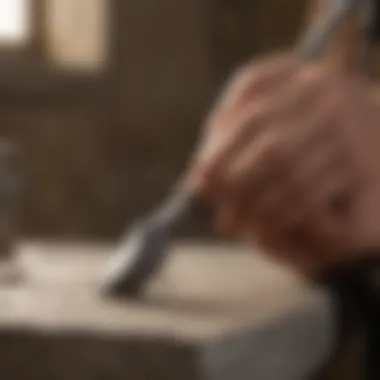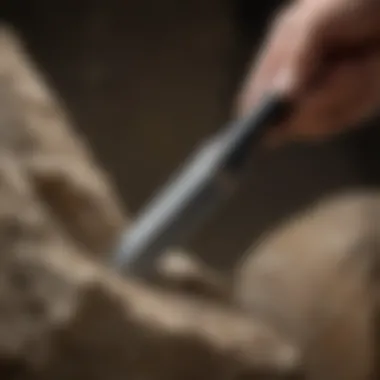Unveiling the Finest Stone Chisels for Avid Rock and Fossil Collectors


Rock and Fossil Identification
In the realm of rock and fossil collection, a crucial aspect for enthusiasts is the identification of these geological treasures. Understanding the various types of rocks and fossils is paramount for any collector aiming to build a discerning collection. Recognizing key characteristics is fundamental in distinguishing between different specimens, aiding in determining their value and rarity. To aid in this meticulous process, specialized tools for identification play a pivotal role, enabling collectors to examine textures, colors, and markings with precision and accuracy.
Collecting Tips and Techniques
Once the identification phase is complete, rock and fossil collectors dive into the art of gathering these prehistoric marvels. Best practices in collecting are essential to ensure the integrity of specimens and minimize any potential damage. Locating prime collecting sites is a skill honed over time, requiring knowledge of geological formations and research into fruitful areas for discovery. Extraction of specimens must be executed with precision and care to avoid compromising the integrity of the rocks or fossils, emphasizing the importance of meticulous handling in the field.
Preservation and Display
Preservation is a critical facet of the rock and fossil collection journey, safeguarding these artifacts for future generations to appreciate. Techniques for preserving rocks and fossils vary, depending on the composition and fragility of the specimens. Implementing proper storage methods is paramount to prevent deterioration and maintain pristine conditions. Furthermore, exploring creative display ideas allows collectors to showcase their finds in captivating arrangements, bridging the gap between scientific exploration and aesthetic appeal.
Geological Insights
Delving deeper into the geological aspects of rock and fossil collection unveils a world of interconnected processes and historical significance. Understanding geological formations and the processes that shape them provides insight into the origins of rocks and fossils, unveiling their unique story through time. The historical significance of these specimens offers a glimpse into the earth's past, reflecting the evolution of landscapes and life forms. Notable discoveries in the field serve as testaments to the relentless pursuit of knowledge and the continuous unraveling of the mysteries that lie beneath the surface.
Introduction
In the realm of rock and fossil collectors, the significance of stone chisels reigns supreme. These tools serve as the mighty instruments that allow enthusiasts to extract and unveil the hidden treasures within geological formations. Without quality stone chisels, the meticulous art of rock and fossil collection would be greatly impeded. As such, this article embarks on an enlightening journey into the world of stone chisels, unraveling the essence of their role and the pivotal role they play in the pursuit of this ardent hobby.
Stone chisels are not mere implements but rather extensions of the collector's hands, enabling precision, control, and finesse in excavating delicate specimens. Understanding the nuances of stone chisels is fundamental for collectors aiming to elevate their craft and achieve superlative results. Through a meticulous examination of chisel types, materials, and features, this guide equips enthusiasts with the knowledge necessary to make informed decisions and enhances their ability to extract geological marvels with finesse.
As we embark on this journey, we delve deep into the intricate world of stone chisels, shedding light on the diverse array of options available to collectors. By elucidating the importance of selecting the right tools and materials, we empower enthusiasts to navigate the complexities of rock and fossil extraction with confidence. This article serves as a beacon of knowledge, illuminating the path towards mastering the art of stone chiseling and unlocking the mysteries hidden within Earth's ancient tapestries.
Understanding Stone Chisels
In this comprehensive article focusing on stone chisels, we delve into the crucial aspect of understanding these tools. Stone chisels play a fundamental role in the toolkit of rock and fossil collectors, facilitating the precise extraction of specimens from various surfaces. By grasping the intricacies of stone chisels, collectors can elevate their excavation processes and ensure the preservation of delicate specimens. Understanding the nuances of different chisel types, materials, and features empowers enthusiasts to make informed decisions that enhance their overall collecting experience.


Importance of Quality Chisels
Quality chisels stand at the core of successful rock and fossil collection endeavors. The durability and sharpness of a chisel can significantly impact the efficiency and accuracy of excavation work. Investing in high-quality chisels not only ensures longevity but also guarantees precision in detail-oriented tasks. Moreover, quality chisels reduce the risk of damaging valuable specimens, making them indispensable tools for serious collectors committed to excellence.
Types of Stone Chisels
Flat Head Chisels
Flat head chisels boast a broad and flat cutting surface, ideal for removing larger sections of rock or fossil material. Their efficient cutting action allows collectors to swiftly extract specimens while maintaining control over the chiseling process. The flat head design excels in creating precise and smooth surfaces, making it a popular choice for intricate excavation work requiring finesse in detailing.
Point Chisels
Point chisels feature a sharp, pointed tip that excels in penetrating dense rock or fossil surfaces with precision. This chisel type is invaluable for creating initial indentations or breaking through tough material layers. The pointed tip enhances accuracy in starting chiseling tasks, offering collectors the control needed to begin shaping specimens effectively.
Tooth Chisels
Tooth chisels are characterized by their toothed edge, which aids in creating textured surfaces or small indentations on specimens. This chisel type is ideal for adding intricate details to extracted pieces or roughening surfaces for artistic purposes. The toothed design provides versatility in chiseling techniques, allowing collectors to achieve diverse textural effects during excavation.
Mallet Chisels
Mallet chisels, designed to withstand greater impact force, are paired with a mallet or hammer to chisel through tough materials effectively. These chisels offer increased control and power, enabling collectors to tackle challenging excavation tasks with precision. The combination of mallet chisels and striking tools enhances efficiency in extracting larger or denser specimens, essential for advanced collection projects.
Choosing the Right Chisel Material
Selecting the appropriate chisel material is crucial in optimizing performance and longevity. Factors such as material hardness, edge retention, and resistance to corrosion directly influence a chisel's effectiveness in excavation tasks. Considerations on the material's ability to maintain sharpness and withstand prolonged use guide collectors in choosing chisels best suited for their specific needs. By understanding the properties of different chisel materials, enthusiasts can make informed decisions that enhance their overall collecting efficiency and satisfaction.
Features to Look for in Stone Chisels


Stone chisels play a vital role in the toolkit of rock and fossil collectors, and choosing the right one can significantly impact the quality of your excavation endeavors. When considering features to look for in stone chisels, several key elements come into play to ensure optimal performance. Firstly, durability and longevity are paramount factors to ponder upon. Opting for chisels crafted from robust materials such as hardened steel or carbide can enhance their lifespan, withstanding the rigors of continuous use.
Additionally, comfort and ergonomics are crucial aspects to evaluate when selecting a stone chisel. The design should prioritize user comfort, with ergonomic handles that reduce strain during prolonged usage. A well-balanced chisel with a comfortable grip can improve precision and control, enabling collectors to work with ease and accuracy.
Moreover, precision and control are essential characteristics that distinguish superior stone chisels. Chisels with sharp, well-defined edges allow for intricate detailing and accurate carving, crucial for delicate excavation work. The ability to maintain control over the chisel's movement is key in achieving precise cuts and shaping, enhancing the overall efficiency and quality of your collecting efforts.
Top Stone Chisels Recommendations
In this section, we delve into the crux of stone chisels recommendations, which serve as the cornerstone for rock and fossil collectors aiming to enhance their excavation experiences. The selection of top-quality chisels is paramount for achieving precision, control, and efficiency in the delicate art of rock and fossil extraction. By recommending specific brands and models, we aim to provide rock and fossil enthusiasts with a detailed roadmap for acquiring the best tools for their craft.
Brand A Chisels
Model X: Best for Detailed Work
Model X stands out as a pinnacle of craftsmanship, tailored precisely for intricate and detailed carving tasks. Its design intricacies allow for immaculate precision and finesse in working with delicate rock formations. The key characteristic of Model X lies in its razor-sharp edges, which facilitate intricate detailing without compromising on durability. This model's popularity stems from its ability to meticulously carve out intricate patterns on rocks and fossils, making it a coveted choice for collectors seeking finesse in their work. The unique feature of Model X is its ergonomically designed handle, which provides unparalleled comfort during prolonged carving sessions. While its precision is commendable, users may find that its lightweight design limits its impact force, requiring a supplementary mallet for more robust materials.
Model Y: Ideal for Rough Carving
Model Y emerges as the go-to choice for rock and fossil collectors dealing with rough and challenging materials. Its robust build and well-balanced construction make it ideal for heavy-duty carving tasks that demand power and effectiveness. The key characteristic of Model Y lies in its sturdy chisel tip, capable of withstanding high impact forces without compromising on performance. This model's popularity thrives on its ability to tackle tough rocks and fossil surfaces with ease, allowing for efficient shaping and carving. The unique feature of Model Y is its anti-vibration technology, which minimizes hand fatigue during prolonged use, enhancing user endurance. While its strength and durability are noteworthy, users may find that its weight hinders intricate detailing and finesse work, necessitating a lighter model for such tasks.
Brand B Chisels
Model Z: Versatile for Various Materials
Model Z emerges as a versatile chisel option, proficient in handling a wide range of materials with finesse and ease. Its adaptability to different rock and fossil compositions makes it a sought-after choice for collectors navigating diverse excavation projects. The key characteristic of Model Z lies in its multi-functional design, capable of seamlessly transitioning between soft and hard materials without compromising on performance. This model's popularity is grounded in its ability to provide consistent results across various materials, ensuring reliability and efficiency in every carving task. The unique feature of Model Z is its adjustable blade angle, allowing for customization based on material density and carving intricacy. While its versatility and adaptability are commendable, users may find that its blade sharpness requires frequent maintenance to sustain optimal carving performance.
Model W: Durable and Reliable


Model W epitomizes durability and reliability in the realm of stone chisels, offering collectors a sturdy and dependable tool for their excavation endeavors. Its robust construction and resilient materials make it a long-lasting companion for challenging rock and fossil extraction tasks. The key characteristic of Model W lies in its hardened steel composition, bolstering its resistance to wear and ensuring consistent performance even under strenuous carving conditions. This model's popularity stems from its unwavering reliability, providing users with a trustworthy tool for all their excavation needs. The unique feature of Model W is its anti-corrosion coating, enhancing its longevity and durability in varying environmental conditions. While its durability and reliability are commendable, users may find that its weight may lead to hand fatigue during prolonged use, requiring intermittent breaks for optimal comfort.
Maintenance and Care Tips
Maintenance and Care Tips are paramount when handling stone chisels for rock and fossil collectors as they help ensure the longevity and efficiency of these essential tools. Careful maintenance can significantly impact the chisels' performance and durability over time. By adhering to proper care routines, collectors can maximize the lifespan of their chisels and maintain their effectiveness for various excavation tasks. Understanding how to clean, store, and sharpen stone chisels is crucial for anyone invested in rock and fossil collection endeavors.
Cleaning and Storage
Cleaning and storing stone chisels correctly is crucial to prevent corrosion, damage, and premature wear. After each use, collectors should meticulously clean the chisels to remove any debris, dirt, or residues that may affect their performance. Using a soft cloth and gentle cleaning solution, such as mild soap and water, can help maintain the chisels' integrity without causing harm. It is imperative to dry the chisels thoroughly before storing them to prevent rust or corrosion. Proper storage is equally vital, as chisels should be kept in a dry, clean environment away from moisture and potential contaminants. Storing the chisels in a protective case or pouch can further safeguard them from external elements and maintain their pristine condition for future use.
Sharpening Techniques
Sharpening stone chisels is a skill that every collector should master to ensure precise and efficient cutting performance. Dull chisels not only impede progress but also pose safety risks during use. Learning the correct sharpening techniques can rejuvenate the chisels' edges and restore their sharpness for optimal cutting results. Utilizing sharpening stones of varying grits, collectors can carefully sharpen the chisel blades by maintaining the proper angle and applying consistent pressure. Regular sharpening not only enhances cutting accuracy but also prolongs the chisels' lifespan by preventing excessive wear on the blades. By dedicating time to sharpening techniques, collectors can elevate their excavation experience and achieve finer results in their rock and fossil discoveries.
Safety Precautions When Using Stone Chisels
In the realm of rock and fossil collection, understanding and implementing safety precautions when using stone chisels stand paramount. Safety is not a mere formality but a fundamental practice that ensures the well-being and longevity of the enthusiast. Mishaps can occur in the blink of an eye when dealing with sharp tools and hard surfaces, underscoring the critical nature of caution. Therefore, it is imperative to delve into the precise measures that guarantee a secure working environment for all involved.
Protective Gear
Central to the safety discourse surrounding stone chisel usage is the adoption of appropriate protective gear. Such gear acts as a shield against potential harm and injury, forming a crucial layer of defense for the collector. Protective eyewear serves as the first line of defense, safeguarding the eyes from flying shards and debris, preserving one's vision intact. Additionally, durable gloves play a pivotal role in shielding the hands from accidental cuts and bruises, ensuring a secure grip on the chisel for precise control. Investing in quality protective gear is not just a precautionary measure but a proactive stance towards a safe and secure collecting experience.
Proper Handling and Technique
Beyond the significance of protective gear lies the essence of mastering proper handling and technique when utilizing stone chisels. Efficient handling involves a meticulous approach to gripping the tool, ensuring a stable and firm hold to avert slips and accidents. Understanding the ergonomics of chisel operation is essential, as it dictates the precision and control one can exert during excavation. Technique comes into play when navigating through different rock surfaces, requiring a nuanced understanding of pressure and angle for optimal results. By honing the art of proper handling and technique, collectors elevate their craft from mere hobbyists to seasoned experts in rock and fossil excavation.
Conclusion
The Conclusion section of this comprehensive guide on stone chisels encapsulates the essence of our exploration into the realm of essential tools for rock and fossil collectors. In the tapestry of rock and fossil collection, the final brush strokes of using the right stone chisel are paramount, akin to the crescendo of a symphony, where each note harmonizes to create a masterpiece. Through meticulous examination and discerning insights, we have unveiled the significance of selecting quality stone chisels, each strike echoing through time and space in the annals of geology.
Immersing ourselves in the world of stone chisels, we have navigated through the labyrinth of choices and considerations, understanding how durability and precision align with craftsmanship in the hands of collectors. Every fissure and fracture on the rock face tells a story, waiting to be unraveled by the deft strokes of a well-chosen chisel. Thus, the tools we wield carry the legacy of the earth within their metallic bodies, enabling us to uncover the mysteries that lay hidden beneath the layers of sediment.
As we reflect on the journey that has brought us to this illuminated point of comprehension, we realize that stone chisels are not merely instruments but extensions of our curiosity and passion for geological wonders. The right chisel becomes a conduit connecting us to the earth's past, a bridge transcending time to bridge the ancients with the contemporary, each strike echoing with the reverence of explorers gone by.







